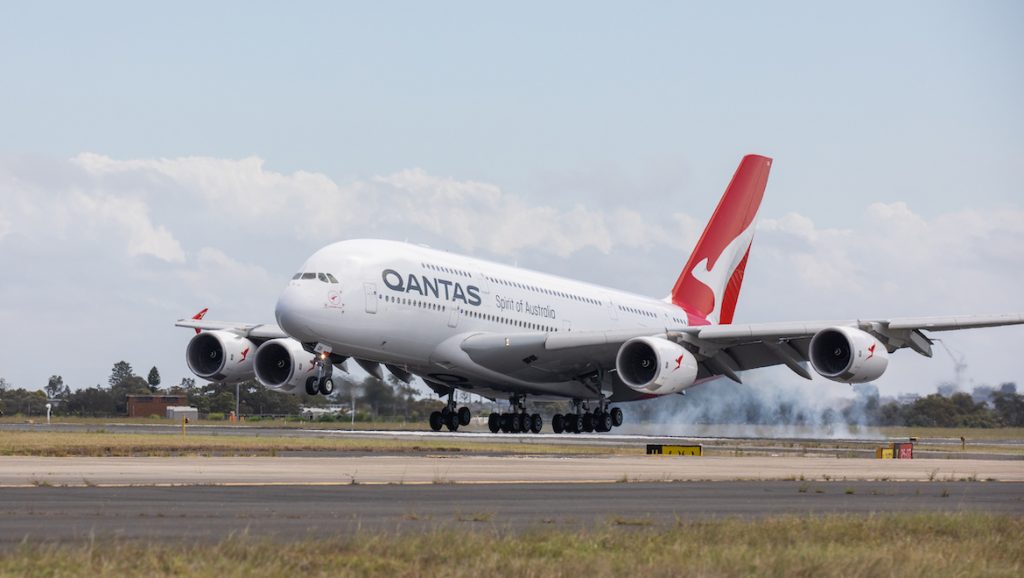
After spending 20 long months in long-term storage, it’s no surprise that the task of returning Qantas’ flagship A380s to service is an onerous one, particularly for the 10 jets that have been grounded in the California desert.
The first Qantas A380 to be removed from long-term storage and return to Australia, VH-OQB, touched down in Sydney on Tuesday after nearly 19 hours in the air, and was met with great fanfare.
After the aircraft touched down on home soil, Australian Aviation was invited to attend Qantas Hangar 96 and witness the arrival of VH-OQB back home for the first time in nearly two years.
Here, we learned exactly how Qantas’ 12 A380 superjumbo aircraft were cared for during their 20-month-long hiatus in the Americas.
Notably, 10 Qantas A380s were stored at the Victorville “boneyard” in the Mojave Desert, while two superjumbos, including OQB, were stored at Qantas’ purpose-built A380 hangar at LAX.
The jets that ended up in the desert needed particular attention from Qantas’ LA-based engineers, explained Scott McConnell, Qantas group engineering executive manager, due to their exposure to the elements.
“Those aircraft have been loved by Qantas engineers based in Los Angeles, who, every week would drive the 200 mile or 300-kilometre round trip [to Victorville],” he said.
McConnell explained that engineers would then check over the aircraft, to ensure these remained sealed and taped up, and that nothing was out of place. However, aircraft being stored in the desert posed other challenges for the engineers in charge of the Qantas A380 fleet.
“One of our biggest issues is rattlesnakes,” McConnell said. “Who would have thought rattlesnakes love hiding in A380 wheels! I’ll tell you what, they do.”
“The team actually made up a “rattlesnake stick” just to get the snakes out,” he added. “So, the fleet up in Victorville will have been well looked after!”
According to McConnell, there is a rigorous process involved in getting an A380 ready to fly, after spending many months on the ground.
“People often ask how much it takes to wake up an A380. To quantify for you, its 4,500 hours of activity – this would take one person almost three years, working every day to get the aircraft ready for service.
“But of course, we have a lot more resources than that, so it takes us about two months to do,” McConnell explained.
In all, Qantas engineers replaced all 22 wheels and 16 brakes on the four-engined jets, as well as all of the emergency equipment on board. The team will also discern other components that need to be replaced, following nearly two years of inaction.
The return of VH-OQB specifically, was a little less labour-intensive, after being stored at LAX rather than in the Mojave Desert.
“For Hudson Fysh, this one’s been in Los Angeles. It last flew with passengers on the 23rd of March last year, so just short of 600 days ago. It flew into Dallas, and a few days later, we flew it back to Los Angeles and it stayed there until August this year,” McConnell said.
“In August, we did a restart on the aircraft, we prepped it and we sent it to Dresden where it had a brand-new set of landing gear.”
Now, Qantas’ engineering team will conduct the last maintenance on OQB before it returns to passenger service in the new year, including work on its engines, and a tidy up of its cabin.
Hudson Fysh will spend the next two to three weeks in Hangar 96 for such work to be completed, before it will be rolled out for use in pilot and cabin crew training, as well as engineering training, McConnell explained.
VH-OQB was ferried from a maintenance facility in Dresden to Sydney this week, taking off at 10:21am local time on Monday, and finally landing at Sydney Kingsford Smith over just under 19 hours later at 3:11pm on Tuesday.
Australian Aviation predicted back in August that VH-OQB could well be the first A380 to return to service, due to the fact that it was one of just two of Qantas’ superjumbos that were grounded at a purpose-built A380 hangar at LAX, rather than stored at the Victorville “boneyard” in the California desert.
At that time, VH-OQB had just been ferried from LAX to a facility in Dresden in order to undergo a scheduled landing gear update ahead of a planned refurbishment. Hudson Fysh has remained in storage at Dresden Airport since.
“After arriving, OQB will enter Hangar 96 where it will spend the next few weeks undergoing additional checks and maintenance by our Sydney engineers,” Qantas said in a staff memo last week, finally confirming our suspicions.
“We’re expecting the aircraft to be available for ground and crew refresher training from mid-December and will have a cabin refurbishment before its return to service.”
The A380 will begin regular passenger service on the Sydney-LA route and is already on the schedule from March 2022.
Named after one of Qantas’ founding members, VH-OQB was delivered to the airline on 15 December 2008 and completed its first passenger service from Sydney to LA as QF11 on 22 December 2008.
















Warwick
says:Nearly as good as ‘snake on a crane’ from a Sth American news item of late!
Just great to see that the ‘big ones’ are returning to the fleet progressively.
Well done, QANTAS, as usual.
Luke Clarke
says:Would be a good story to have on the pilots, and how they have been involved in the process too. Sim checks, training. Would be interesting.
Neil
says:Glad i am not checking those Brakes!!!Great to see those Big Birds coming back and flying Qantas again.